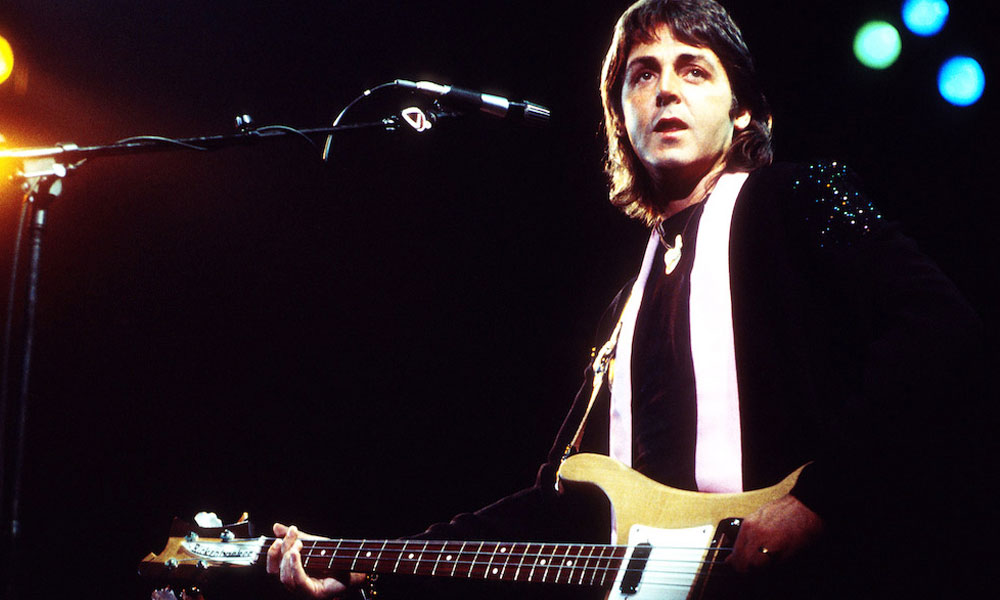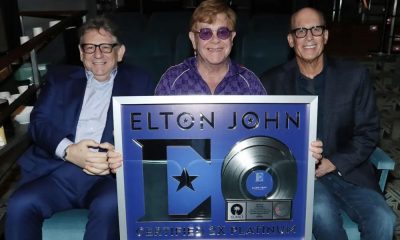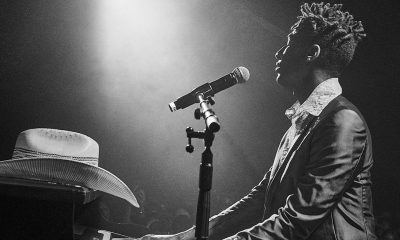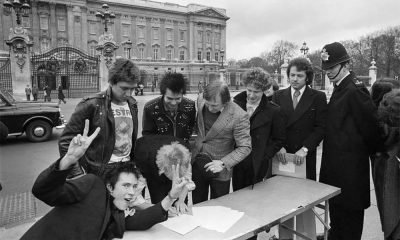Features
Best Paul McCartney Songs: 20 Post-Beatles And Solo Tracks


By the time The Beatles split, in 1970, Paul McCartney had already accomplished more than any musician could have hoped for. Having helped change the face of music on several occasions, he could have spent his post-Beatles life in semi-retirement, emerging solely to remind us of his past accomplishments. As a solo artist, however, McCartney continued to shape pop and rock music, whether with new collaborators (Wings, his wife Linda, Elvis Costello, producer Nigel Godrich) or simply following wherever his creative muse led. The best Paul McCartney post-Beatles and solo songs, then, pay tribute to that relentless drive to keep finding new modes of expression.
Listen to the best Paul McCartney solo songs on Apple Music and Spotify, and scroll down for our list.
20: Early Days (2013)
One of the interesting aspects of Paul McCartney’s 2013 album, NEW, is that the production credits feature Giles Martin and Ethan Johns, successful young producers, but – more significantly – the respective sons of George Martin and Glyn Johns, both of whom had produced The Beatles. From the sessions with Ethan Johns came “Early Days,” a song about Macca’s carefree teenage years back in Liverpool. “On the day I wrote the track ‘Early Days’ I was thinking about the past, particularly me and John in Liverpool in the early days, so I just ran with that,” Paul explained. “I started to get images of us in the record shop listening to early rock’n’roll and looking at the posters, and the joy that gave me remembering all those moments.”
19: I Don’t Know (2018)
Given that Paul McCartney is known for his seemingly unwavering positivity, it was a surprise when his 2018 album, Egypt Station, opened with the lyrics “I got crows at my window, dogs at my door/I don’t think I can take any more.” Indeed, the lead single from the No.1 album finds Paul in soul-searching mode. “Sometimes in your life, you’re not a god on Olympus. You’re a real person walking round the streets. I’m a grandfather, a father, a husband, and in that package there’s no guarantee that every minute’s gonna go right,” he said, adding, “In fact, quite the opposite. And there was a private occasion – I’m not gonna get into it – that brought me down. ‘God, what am I doing wrong?’ I’m not knocking it, I have a great life. But from time to time, reality intrudes.”
18: Letting Go (1975)
Taken from Wings’ 1975 album, Venus And Mars, “Letting Go” is a slinky, funky song with such an infectious groove that Paul McCartney still enjoys playing it live today. The basic track was laid down at EMI’s Abbey Road studios in early 1975, but one of the song’s features – a stabbing brass section – was added later, in New Orleans. It was around this time that John Lennon, according to his then-girlfriend May Pang, was planning to head to New Orleans and work with his old bandmate again. However, so the story goes, once Lennon was reunited with his wife, Yoko Ono (in part thanks to help from Paul), the plan was abandoned.
17: Waterfalls (1980)
After his incarceration in a Japanese jail for drug offenses in 1980, Paul McCartney returned home to England and released his first solo album since 1970’s McCartney. Appropriately titled McCartney II, the album was characterized by Paul inventing songs on his own in his studio while experimenting with synthesizers and other electronic instruments. About halfway through the process, he decided to return to the only McCartney II song he wrote before the sessions. As Paul explained: “‘Waterfalls’ is basically saying don’t go doing a load of dangerous stuff, ’cause I need you. And that’s a kind of a more mature thought for me than I would have been able to have done 20 years ago, ’cause I just didn’t realize that it’s not all gonna be here forever. That’s the kind of thing you realize when you pass 30.”
16: My Brave Face (1989)
In many respects, 1989 was a turning point in Paul McCartney’s solo career. That year’s Flowers In The Dirt album went to No.1 and was the launching pad for Paul’s first world tour since the mid-70s. He pulled out all the stops for the album, working with Elvis Costello as his songwriting partner on many tracks, including the lead single, “My Brave Face.” That session marked the first time Paul had used his iconic Hofner “violin” bass for many years, adding a certain Beatles-like sound to the song. Describing their working process to Paul du Noyer, McCartney said, “We got these songs, a bit different for me, a little more wordy than if I’d written them. He’s very much into words, Elvis. He’s a good foil for me, and I think I’m a pretty good foil. I Foil Fine. I write something and he’ll sort of edit it, and provided I don’t mind, that goes OK.” As for Costello, he admitted: “Inevitably there was a bit of, ‘Fuckin’ hell, it’s Paul McCartney.’”
15: Jenny Wren (2005)
For this haunting number from 2005’s superb Chaos And Creation In The Backyard, Paul McCartney returned to a practice that had served him well down the years. “Jenny Wren” uses a similar style of acoustic guitar picking to songs such as “Blackbird”, “Mother Nature’s Son” and “Calico Skies.” But who was the mysterious Jenny Wren? According to Paul, it was just a character he made up while thinking about birds: “A wren is one of my favorite birds, little English bird, it’s the smallest English bird and I always feel very privileged to see a wren because they’re very shy and it’s just, Ah! So a combination of all of that. It’s a favorite bird for me, and then instead of making it a bird, again like ‘Blackbird,’ only more definitely this time I made it a woman, you know, a girl.”
14: Coming Up (1980)
The video for “Coming Up” sees Paul McCartney take on many guises for his fantasy Plastic Macs band, including Ron Mael from Sparks, Hank Marvin (often thought to be Buddy Holly), and a country-bumpkin drummer based on his friend John Bonham. “I originally cut it on my farm in Scotland. I went into the studio each day and just started with a drum track. Then I built it up bit by bit without any idea of how the song was going to turn out. After laying down the drum track, I added guitars and bass, building up the backing track,” Paul explained. Among the song’s fans in New York was John Lennon, who described “Coming Up” as “a good piece of work” that supposedly inspired Lennon to start recording again.
13: Goodnight Tonight (1979)
It shouldn’t be forgotten that Paul McCartney’s chief musical role in The Beatles was originally as bass player – something evident in this single born out of an infectious disco bassline and a flamenco-inspired rhythm. Having recently signed with Columbia Records, Paul’s new label wanted him to include the commercial “Goodnight Tonight” on his Back To The Egg album, a suggestion Paul gave short shrift: “I’m making records, I’m not running a record store.”
12: Too Much Rain (2005)
Paul McCartney has admitted that the inspiration for “Too Much Rain” came from Charlie Chaplin’s song “Smile,” which features the lines “Smile, though your heart is aching/Smile, even though it’s breaking.” In “Too Much Rain,” Paul alludes to a life with too much sadness – often interpreted as a reference to the deaths of those closest to him: his mother, John Lennon, his wife Linda, George Harrison. The song opens “Laugh, when your eyes are burning/Smile, when your heart is filled with pain”, and is one of the stand-outs from his acclaimed 2005 album, Chaos And Creation In The Backyard, produced by Nigel Godrich.
11: Pipes Of Peace (1983)
At the 1983 Brit Awards, Paul McCartney won in the Best British Male Solo Artist category. He ended the year releasing “Pipes Of Peace” as a single just before Christmas, and gave it an award-winning video that recreated the legendary First World War Christmas truce. Paul plays the role of both a British and German soldier who meet in no man’s land, in the trenches, sharing photos of their girls back home before explosions reignite the conflict. A timeless anti-war anthem, the song features one of Paul’s most interesting arrangements of the decade: table, pan flutes, reggae passages, marching drums and a choir contribute to a single that topped the UK charts in January 1984.
10: Uncle Albert/Admiral Halsey (1971)
Paul McCartney has always enjoyed creating whole songs by joining fragments of different other songs together (see his and John Lennon’s “A Day In The Life” and the famous Abbey Road medley). This micro-medley of contrasting ideas and themes topped the US Billboard chart in September 1971, earning Paul a Grammy along the way. “I had an uncle – Albert Kendall – who was a lot of fun, and when I came to write ‘Uncle Albert’/‘Admiral Halsey’ it was loosely about addressing that older generation, half thinking, What would they think of the way my generation does things?” Paul explained. “That’s why I wrote the line ‘We’re so sorry, Uncle Albert.’ There’s an imaginary element in many of my songs – to me, Admiral Halsey is symbolic of authority and therefore not to be taken too seriously.”
9: No More Lonely Nights (1984)
The theme song to Paul McCartney’s 1984 movie Give My Regards To Broad Street proved to be one of his finest singles of the 80s. It was born out of Paul messing about in the studio and, once written, it came together very quickly. As Pink Floyd’s Dave Gilmour, who plays lead guitar on the song, later recalled: “I found it quite amazing doing ‘No More Lonely Nights’ with Paul McCartney. In one three-hour session with a band we learned it and put it down, and Paul played piano and sang the lead vocal live, and I put the guitar solo down, bang.”
8: Say Say Say (1983)
There are photos of Paul McCartney and Michael Jackson at the kitchen sink, doing the dishes together. An unlikely scene, perhaps, but when Michael flew over to England to write with Paul, he enjoyed the McCartneys’ down-to-earth home life. As Paul explained, “We sat around upstairs in my office in London, I grabbed a guitar and ‘Say Say Say’ came out of that. He helped with a lot of the words. It’s not a very wordy song but it was fun working with him because he’s enthusiastic.” A 2015 remix only served to bring out the innate funkiness in what had been a No.2 hit for the pair in 1983.
7: Beautiful Night (1997)
An attempt to record this classic Paul McCartney ballad in August 1986 proved unsatisfactory, and the song was shelved for over a decade, before Paul called on an old friend named Ringo Starr to help him get this Flaming Pie track right. “Ringo and I had not worked together for a long time before we did ‘Free As A Bird,’” Paul explained. “Then we did ‘Real Love’ and it was just such a laugh that I said I was doing a new album and I’d love him to drum on a couple of tracks.
“So I got ‘Beautiful Night’ together, Ringo came down to my studio and we did it and it was such great fun. It was really good to see that Ringo and I locked in, The Beatles’ rhythm section, drum and bass, we just locked in. It would have been kind of disappointing if we’d lost it, but we hadn’t. I suppose we’d just played together for so many years with The Beatles that it was still there and really easy to record together.”
6: The Back Seat Of My Car (1971)
The big closer on Paul and Linda McCartney’s Ram album, “The Back Seat Of My Car” is Paul writing from the point of view of a teenager (“Even though it was a long time since I was a teenager and had to go to a girl’s dad and explain myself”), intent on conquering the world, his girl at his side, with nothing but the open road in front of them. As he told Mojo magazine, “That’s a really teenage song, with the stereotypical parent who doesn’t agree, and the two lovers are going to take on the world: ‘We believe that we can’t be wrong.’ I always like the underdog.”
5: Here Today (1982)
“I wrote ‘Here Today’ about John,” Paul McCartney told Paul du Noyer about this touchingly simple song from his 1982 album, Tug Of War. In the lyric, Paul sings “What about the night we cried?” which he has since explained refers to one night during The Beatles’ touring days, when he and John stayed up talking all night and eventually talked about the shared loss of their mothers as teenagers. It wasn’t until 20 years after the song’s release that Paul first played it live, but it is now one of the most touching moments of his live show, alongside his cover of George Harrison’s ”Something”.
“At least once a tour, that song just gets me,” he told The Guardian. “I’m singing it, and I think I’m OK, and I suddenly realize it’s very emotional, and John was a great mate and a very important man in my life, and I miss him, you know? It happened at the first show, in Gijon: I was doing fine, and I found myself doing a thing I’ve done in soundcheck, just repeating one of the lines: ‘I love you, I love you, I love you.’ I did that and I thought, That’s nice – that works. And then I came to finish the song, to do the last verse, and it was, Oh shit – I’ve just totally lost it.”
4: Every Night (1970)
One of the stand-out tracks from his 1970 eponymous debut album, “Every Night” addressed Paul McCartney’s darkest days (and nights): “Every night I just wanna go out, get out of my head/Every day I don’t wanna get up, get out of my bed.” By his own admission, in the immediate aftermath of The Beatles’ split, Paul struggled with the way things had panned out. “You’ve gotta imagine having your three best mates suddenly be against you,” he said. “And, yeah, I must admit, I hit the bottle, I hit substances. It was a very difficult period for me.”
3: Live And Let Die (1973)
When he was asked to provide the theme song for the 1973 James Bond movie, starring Roger Moore, Paul McCartney was flattered: “As a songwriter it was always one of my ambitions to compose a James Bond film song. I realized it wouldn’t be easy, but it appealed to me.” With an orchestral arrangement and production from George Martin, “Live And Let Die” soon developed into an epic of huge hit-making potential. When Martin delivered the completed track to the filmmakers, however, he was amazed by their response: “Who are we going to get to sing it in the film? What do you think of Thelma Houston?” A flabbergasted George Martin responded, “But you’ve already got Paul McCartney!” Eventually, the producer won the argument, and Paul’s version became a top 10 hit on both sides of the Atlantic. Two decades later, a cover by Guns N’ Roses took the song back into the charts.
2: Maybe I’m Amazed (1970)
The first major production number of Paul McCartney’s solo career, “Maybe I’m Amazed” may sound like a hit record, but it wasn’t actually released as a single until a live version was put out in the wake of the Wings Over America live triple-album in 1976. One of Paul’s greatest love songs to his wife Linda, “Maybe I’m Amazed” remains a showpiece of his live concerts; the passion in his delivery is, if anything, more tangible today than when he first recorded the song in his 20s.
1: Band On The Run (1973)
For Paul McCartney, the early 70s involved much soul searching about what he would do after The Beatles. First a solo album, then one recorded with his wife Linda, after which he formed Wings. But without the commercial or critical success to which he’d grown accustomed, Paul could have been forgiven for thinking all was against him when, on the eve of departing for Nigeria to record the 1973 album Band On The Run, Wings’ drummer and lead guitarist quit the band. In response, Paul redoubled his efforts, taking on drumming duties, as he had on occasion in The Beatles, and the resulting album finally gave Paul the international hit he’d been building towards. Significantly, Band On The Run was praised by John Lennon, who described it as “a great song and a great album.”

-
Paul McCartney And Wings To Release Historic Live Album ‘One Hand Clapping’
-
Elton John Earns Multi-Platinum Plaque For ‘Diamonds,’ Shares ‘Step Into Christmas’ EP
-
Jon Batiste Announces ‘Uneasy Tour: Purifying The Airwaves For The People’
-
Best Political Punk Songs: 20 Essential Anti-Establishment Tirades





